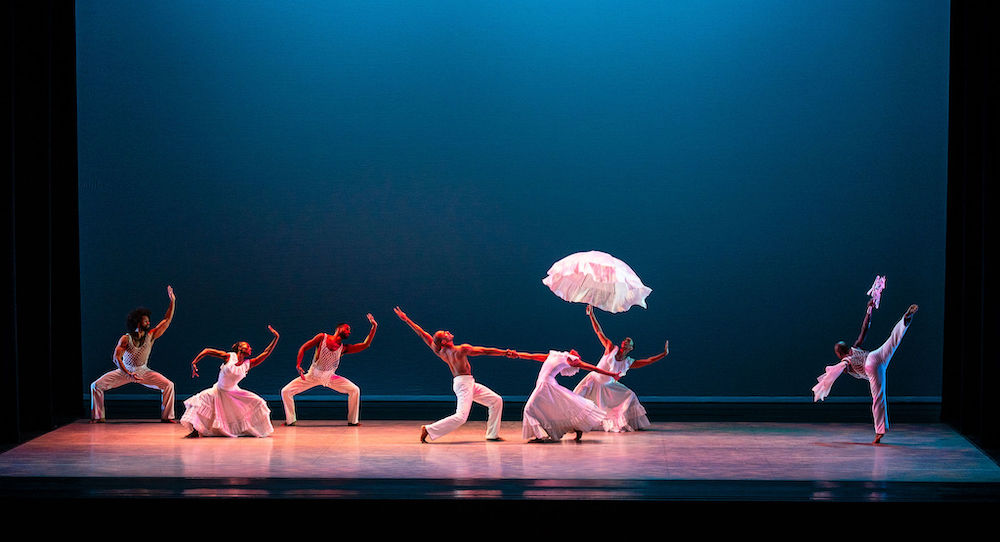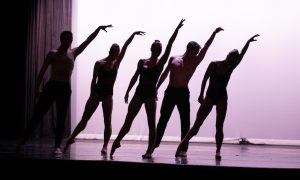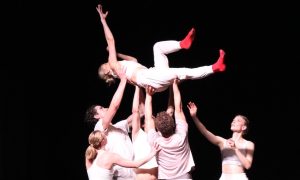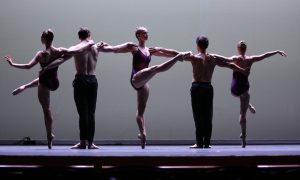The Boch Center – Wang Theater, Boston, MA.
May 5, 2024.
I’ll admit it – I didn’t get a chance to browse the works scheduled for the Alvin Ailey American Dance Theater program I’d be attending, through the Celebrity Series of Boston. Seated in the theater and ready for the show, a friend and I browsed the program. I noticed that some of the works on deck I’d seen before, some I hadn’t, yet all were classics choreographed by Alvin Ailey himself. The program was even called “Ailey Classics.”
I always love seeing fresh work from contemporary choreographers, but I was excited to take in these tried-and-trues. There were also many shorter “excerpts,” rather than full-length works – offering the aesthetic and flavor of many works. This dance buffet left me quite satiated. While I could go on and on about the value – even importance – of resourcing and platforming new works, there’s a comfort and wonder in coming back to classics like these.
Those works I saw before included the jazzy, bright and exuberant Reflections in D (1963); the introspective and soothing Memoria (1979); and Night Creature (1974), chalk-full of vivacious movement and nocturnal ambiance. And of course, per usual, the iconic Revelations (1960) closed the program: nothing short of a spiritual experience, the first and every time.
An excerpt from Pas de Duke (1976), to a Duke Ellington tune, was a short and sweet pas de deux (get it?…apologies to those who dislike puns). Both spirited and serene, it juxtaposed duality and unity. One dancer wearing white and another black brought a sense of the yin and yang. The piece’s structure related them accordingly: distinct, but inextricably linked.
Jazz dance vocabulary, from rolling hips to tight, quick footwork, infused just a dash of the funky. Repeated movement vocabulary became almost mantras in movement, further instilling that calm in the atmosphere. There’s a comfort and ease in the familiar. The movement looked like it felt so good to dance, why not do so again…and again? It was so pleasing to experience that I had no complaints there…indulge and savor away, dancers.
Another excerpt, from Masekela Langage (1969), set movement to music of Hugh Masekela. It was more memorable in design than in movement, yet memorable nonetheless. Chenault Spence’s lighting painted the stage in red and black. Projected rectangles on the backdrop were reminiscent of window panes – which also matched the stripes in the main soloist’s dress (costumes from A. Christina Giannini). It was a cohesive atmosphere of nighttime mystery, with just a pinch of postmodern abstraction.
The whole ensemble, but that soloist in particular, seemed fully absorbed in the dopamine rush of movement: strong, supported and free. Whether the sense of that absorption was characterization or that which the performers authentically felt, the effect was the same; I couldn’t help but share in their joy. The work was also another example of Ailey’s movement idiom, an unparalleled blend of his various movement influences: jazz, modern techniques, African diasporic forms, and more.
An excerpt from Opus McShann (1988) paired a suave, sophisticated male duet with bluesy jazz from Jay McShann and Walter Brown. The movement was notably fluid, the dancers’ spines swerving and rippling along with the score’s trills and riffs. Suited up in slacks and collared shirts, they were formal and dapper. Freedom and refinement danced hand-in-hand – not in tension, but in complement.
The dancers related through frequently dancing in unison, not as much in physical or eye contact. To end, however, they walked offstage together – as if having truly discovered each other. We in the audience could witness this discovery, this shift from a kind of connection to a fuller unity. It was another short-and-sweet work, a tasty nugget of dance. It was all I, at least, needed to be moved in my own way.
The next excerpt was from Love Songs (1972), another pleasing nugget of exquisite musicality and pure movement innovation. Choreography and atmosphere – with lighting from Shirley Prendergast and costume from Ursula Reed – together built the deep drama of the stickiest, most emotional love songs.
Yet, that emotionality steered clear of melodrama or eye roll-inducing cliché. The choreographic attention to the score’s nuances, as well as the dancers’ authenticity in each unspoken interaction and moment in movement, kept the realism onstage ringing strong and true. Even with such an outward-presenting, highly dramatic sense at hand, I felt a profound introspection. Grounded in inner truth and knowing, an offering then shined outwards.
Two separate excerpts from For ‘Bird’ – With Love (1984) bookended Reflections in D. When it came to building that nocturnal mystery, the possibility in the air under moonlight, we hadn’t seen anything yet. In the first excerpt, set to Dizzy Gillespie and Frank Paparelli’s “A Night in Tunisia”, dancers executed clean pirouettes while holding brass instruments (and my jaw dropped in amazement). It was big band night at the night club, and all had shown up to play.
In this sultry jazz club world, with set and costume design from Randy Barcelo and lighting from Timothy Hunter, I got a sense of the multiplicity in a place like Tunisia – where cultures and traditions mix, meld, and take on their own flavor. The second excerpt, set to Coleridge-Taylor Perkinson’s “Bird Lives”, felt a bit more formal and stoic – yet no less vibrant.
The lively music even seemed to power the ensemble – towards the end, a trumpet singing proudly pushing them forward through the last stretch of highly athletic movement. Such keen musicality is only characteristic of Ailey’s larger body of work. Harmony results, the kind that can feel all too lacking in this world. I didn’t need full-length pieces for that to vibrate through me. The resonances of the dancers’ momentum translated into my own body and soul.
Through these excerpts, we also got a more representative feel for Alvin Ailey’s broader vision as an artist (may he always rest in power). We could bask in his classic creations for a bit, before it was back again to the 21st century. Thank you, Alvin Ailey American Dance Theater, for inviting us in for a short while – too short a time, yet an exceedingly satisfying one.
By Kathryn Boland of Dance Informa.













